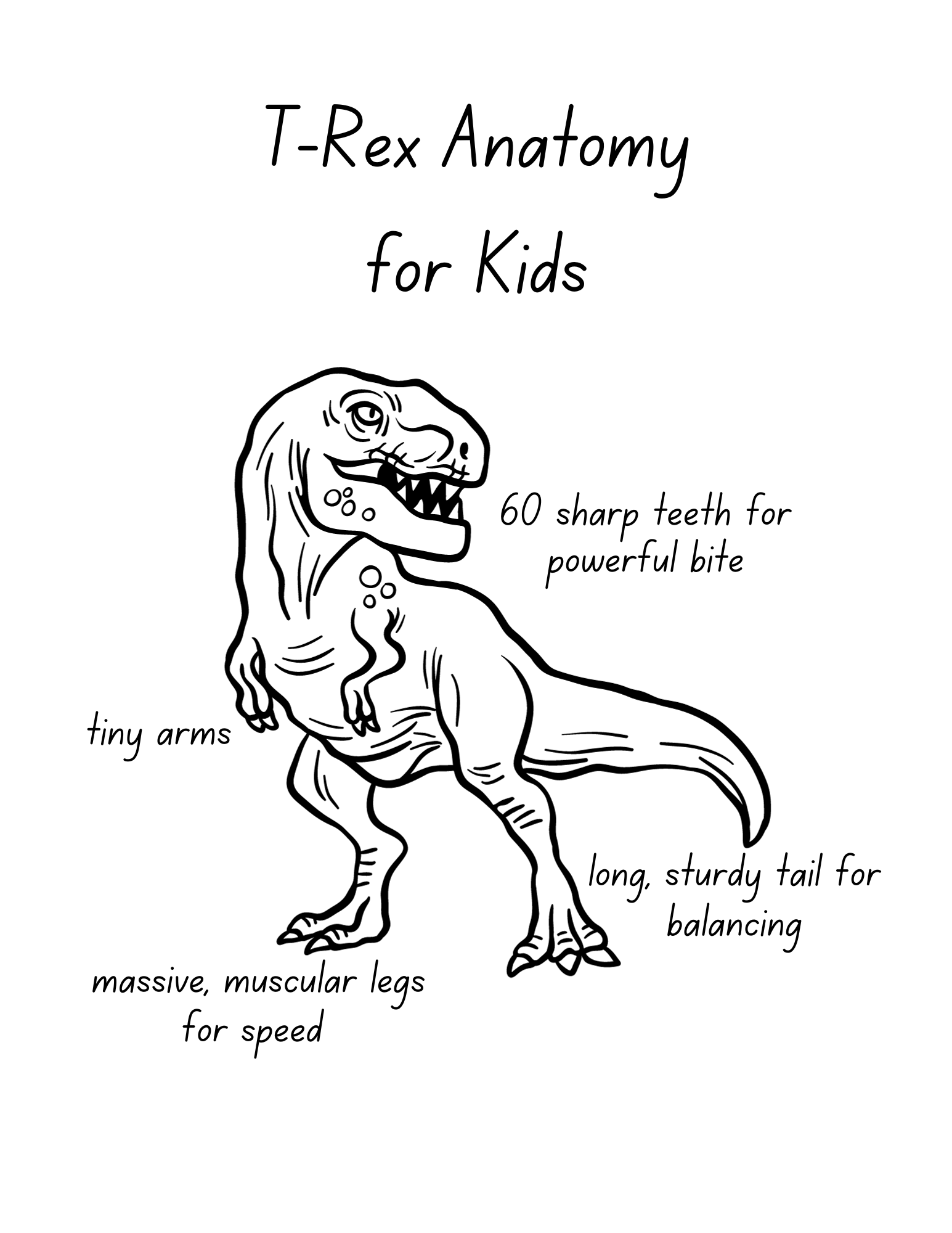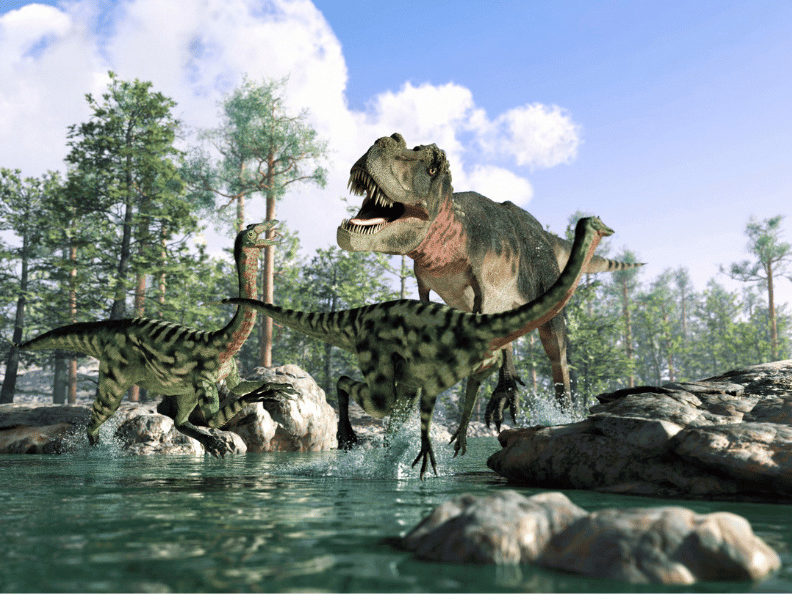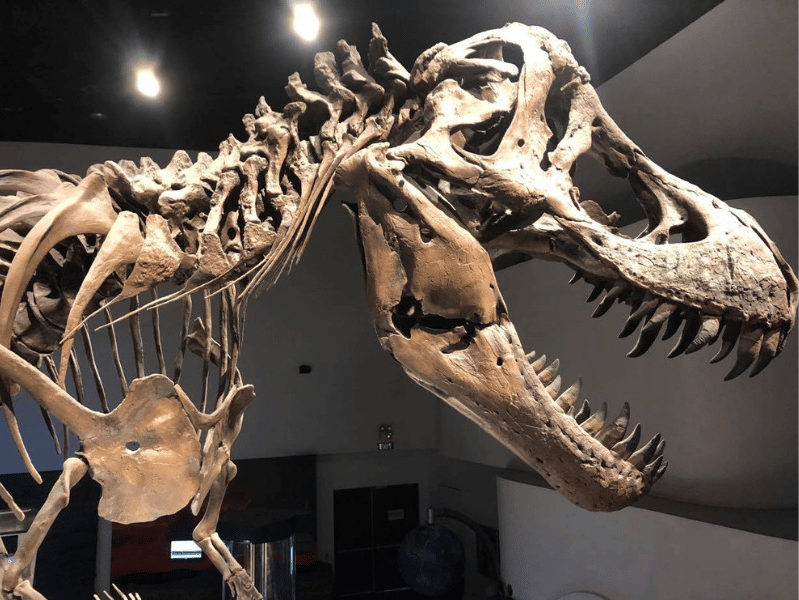Welcome, curious minds and aspiring paleontologists! In this comprehensive guide -“All About Tyrannosaurus Rex,” we’ll embark on an exciting journey into the world of one of the most iconic dinosaurs to ever roam the Earth – the Tyrannosaurus Rex (T-Rex).
If you’re a parent on a mission to ignite your child’s fascination with dinosaurs, you’ve come to the right place. Buckle up for a prehistoric adventure as we uncover fascinating facts that will captivate your child’s imagination and fuel their love for learning.
Let’s look at what makes the T-Rex so cool and scary, making people who love dinosaurs, whether young or old, really interested. We’ll uncover the awesome things about the T-Rex in this adventure into the past!
All About Tyrannosaurus Rex – Exploring T-Rex Anatomy
Massive Size
The T-Rex was a giant, with an average length of about 40 feet and weighing in at an imposing 9 tons. Its big size grabbed attention and respect in the ancient landscapes it roamed.

Now, let’s talk legs – the T-Rex’s powerhouse! Imagine massive, muscular legs supporting the king’s hefty frame. These legs weren’t just for strutting around; they were built for speed and strength. The T-Rex could run surprisingly fast for its size, making it a fearsome hunter. Its legs were like powerful engines, propelling it forward with each thunderous step.
Powerful Jaws
Let’s start with the T-Rex’s most fearsome feature – its teeth! The T-Rex had about 60 teeth, and each one was designed for one thing: slicing through meat. Armed with serrated, razor-sharp teeth, these jaws could deliver bone-crushing bites, easily capable of pulverizing the bones of its prey.
The force generated by the T-Rex’s bite is estimated to be one of the most powerful in the animal kingdom, adding to its formidable reputation.These sharp teeth weren’t just for show; they were the key to the T-Rex’s powerful bite, making it a top-notch predator in the dino-world.
Tiny Arms, Big Mystery
Now, let’s address the intriguing enigma of the T-Rex’s tiny arms. While it might seem funny, these arms were a mystery to scientists. Scientists speculate about their purpose, suggesting roles in hunting, mating, or even balance. Regardless of their function, the T-Rex’s tiny arms have become an iconic and endearing feature, sparking curiosity and fascination.
Impressive Tail: The Balancing Act
Last but not least, let’s not forget the T-Rex’s tail – a majestic balancing act! Envision a long, sturdy tail extending from the king’s rear. This tail wasn’t just for looks; it played a crucial role in helping the T-Rex maintain balance while on the move. Think of it like a dinosaur tightrope, keeping the massive creature stable as it navigated its prehistoric terrain.
Bringing It All Together
Now that we’ve taken a close-up look at the T-Rex’s anatomy, imagine how all these features worked together. The sharp teeth for biting, the strong legs for chasing, the tiny arms for who-knows-what, and the impressive tail for balance – each part played a special role in making the T-Rex the ultimate dinosaur king.
As we continue our journey into the world of the Tyrannosaurus Rex, remember these incredible details that make the T-Rex a fascinating creature. Get ready for more dino-adventures as we uncover the mysteries of the Cretaceous Period and discover just how amazing the king of dinosaurs truly was!
Life in the Cretaceous Period: T-Rex’s Reign
Imagine stepping into a time machine, transporting you back to the Cretaceous Period, a time when the mighty Tyrannosaurus Rex ruled the land. The environment during this prehistoric era was a breathtaking tapestry of landscapes, climates, and fascinating creatures.
Environment
A long time ago, from 145 to 66 million years ago, there was a special time called the Cretaceous Period. During this time, the world looked different. There were big seas in the middle of the land, separating it into pieces. Also, there were lots of big, green forests with tall plants like ferns, conifers, and strange-looking cycads. The world was lively and filled with greenery.
Climate
The climate was generally mild, with warm temperatures creating a unique ecosystem. Back in the time of the dinosaurs, the weather was usually nice and not too hot or too cold. It was like a big, comfy blanket for the plants and animals. Imagine feeling gentle winds blowing through the leaves of really old plants, and sometimes it rained to give water to everything, making the land full of different kinds of living things.
Also, the ice at the top and bottom of the Earth was smaller back then. This cozy climate helped lots of plants and animals to live happily.
Other Dinosaurs
Now, let’s meet the neighbors that shared this prehistoric neighborhood with the T-Rex.The Cretaceous Period was a bustling era for dinosaurs, and the T-Rex shared its kingdom with an impressive array of fellow prehistoric giants.
- Triceratops
Imagine a creature with three sharp horns on its face – the Triceratops! This herbivorous dinosaur roamed the same lands as the T-Rex, and its impressive horns served as both defense mechanisms and tools for foraging.
sharp horns on its face – the Triceratops! This herbivorous dinosaur roamed the same lands as the T-Rex, and its impressive horns served as both defense mechanisms and tools for foraging.
These gentle giants coexisted with the T-Rex, representing the herbivorous side of the Cretaceous food chain.
- Stegosaurus
Despite its herbivorous diet, the Stegosaurus lived alongside the T-Rex, showcasing the diversity of the prehistoric ecosystem.
- Velociraptor
Although not as big as the T-Rex, these speedy predators with sharp claws added an extra layer of excitement to the Cretaceous landscape.
While not as large as the T-Rex, the Velociraptor was a dynamic predator, contributing to the intricate balance of life during this era.
- Hadrosaurs:
Imagine herds of Hadrosaurs, duck-billed dinosaurs that roamed the Cretaceous landscape. These herbivores provided a significant food source for predators like the T-Rex.
All About Tyrannosaurus Rex -The Circle of Life
In this dynamic ecosystem, the T-Rex was not just a mighty ruler but a crucial part of the intricate web of life. Its role as a top predator helped maintain balance, ensuring that different species coexisted harmoniously. The Cretaceous Period was a stage for an incredible variety of life, and the T-Rex stood tall at the center of it all.
As an apex predator, it sat at the top, preying on herbivorous dinosaurs like Triceratops and Edmontosaurus. The T-Rex’s voracious appetite ensured a delicate balance in the ecosystem – a necessary component for the survival of all species within the Cretaceous food web.
T-Rex’s hunting strategies and role in the ecosystem were pivotal. Its sharp senses, powerful legs, and position at the top of the food chain made it a crucial player in maintaining balance. As we continue our exploration into the T-Rex’s world, remember that the king of dinosaurs wasn’t just a fearsome hunter – it was a key contributor to the intricate web of life in the prehistoric Cretaceous Period.
Fun Facts: T-Rex’s Hunting Habits
- Team Player: Contrary to popular belief, T-Rex might have hunted in groups. Working together, they could take down even larger prey.
- Bone-Crushing Bite: The T-Rex’s bite was so powerful that it could crush bone, ensuring it could devour its meals efficiently.
- Scavenger Skills: While the T-Rex was a fearsome hunter, it wasn’t above scavenging. It would opportunistically feast on the remains of other dinosaurs’ kills, showcasing its adaptability.
Tyrannosaurus Rex fossils
Tyrannosaurus rex fossils have been discovered in various locations around the world, providing valuable insights into the life and times of this iconic dinosaur. Some notable Tyrannosaurus rex fossil locations include:
- Hell Creek Formation (United States)
The Hell Creek Formation, spanning parts of Montana, North Dakota, South Dakota, and Wyoming, is a famous site for T-Rex discoveries. Many well-preserved T-Rex fossils, including Sue, one of the most complete T-Rex skeletons ever found, were unearthed here.

- Two Medicine Formation (United States)
Located in Montana, the Two Medicine Formation is another site in the United States known for T-Rex fossils.
- Dinosaur Provincial Park (Canada)
In Alberta, Canada, Dinosaur Provincial Park is a UNESCO World Heritage Site and a rich source of dinosaur fossils, including those of Tyrannosaurus rex.
- Lance Formation (United States)
The Lance Formation, found in Wyoming, Montana, and South Dakota, has yielded T-Rex fossils along with other dinosaur specimens. This formation is known for its well-preserved fossils that provide clues about the ancient environments where these dinosaurs lived.
- Gobi Desert (Mongolia)
T-Rex fossils have also been found in the Gobi Desert of Mongolia.
- Central Asia (Kazakhstan)
Fossils of Tyrannosaurus rex have been reported in Central Asia, specifically in Kazakhstan.
Pop Culture Star
The Tyrannosaurus Rex, or T-Rex, isn’t just a star of the prehistoric past; it’s a pop culture sensation that has left an indelible mark on movies, cartoons, toys, and video games
The T-Rex made a colossal entrance into pop culture with the 1993 blockbuster film, Jurassic Park. Imagine the first time you saw the T-Rex on screen, its mighty roar shaking the ground. This cinematic masterpiece not only brought the T-Rex back to life but also sparked a renewed fascination with dinosaurs, captivating audiences worldwide. The T-Rex became the symbol of awe and fear, making it a legendary figure in the realm of cinema.
The T-Rex didn’t stop at the big screen – it stomped its way into the world of animated entertainment,toy playsets,video games
From the silver screen to the toy aisle, from video game realms to advertising landscapes, the T-Rex has roared its way into every corner of pop culture. Its presence continues to captivate audiences of all ages, leaving an enduring legacy that showcases the timeless appeal of this iconic dinosaur.
This iconic dinosaur has become a favorite among enthusiasts of all ages, captivating the human imagination through generations. Its role as a symbol of power and strength has permeated popular culture, from books and movies to toys and museum exhibits. The T-Rex stands as a testament to the incredible diversity and majesty of the prehistoric world.
As we unravel the mysteries surrounding the Tyrannosaurus Rex, it’s clear that this colossal creature was more than just a giant lizard. It was a symbol of dominance, a force of nature that left an indelible mark on the ancient landscape. From its massive size and powerful jaws to its enigmatic tiny arms, the T-Rex continues to fascinate and inspire kids and adults at the same time.

